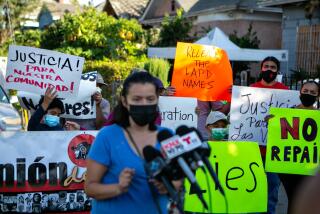City Council Acts to Prevent Another Methane Explosion
- Share via
After more than a year’s study, the Los Angeles City Council Tuesday tentatively adopted measures designed to prevent a recurrence of last year’s methane gas explosion in a Fairfax area clothing store.
Without debate, the council ordered drafting of an ordinance to require existing and new residences with basements to install gas-detection devices in below-ground areas. Commercial buildings would be required to meet new ventilation standards in their basements or install gas detection devices.
The requirement would apply to a 400-block Westside area identified as a “potential risk zone” by a city task force that investigated the cause of an explosion and fire at the Ross Dress for Less store in March, 1985. Twenty-one people were injured in the blast, which was attributed to gas that was formed by decomposing organic material and seeped into the building.
A typical home detection system is estimated to cost $1,000 to $1,500, although the costs could drop substantially, depending on what standards the city adopts for the units, according to city officials. Commercial systems could cost up to $3,750.
A spokeswoman for Councilman Zev Yaroslavsky, who represents much of the affected area but who was not present for Tuesday’s vote, said the councilman wants additional information on the costs homeowners might face.
Joe Cobarrubias, a city geologist, estimated that 12% to 15% of the homes in the Fairfax area may have basements. If the ordinance receives final approval, the city would notify all homeowners and businesses of the new requirements and follow up with inspections, Cobarrubias said.
The proposed ordinance also establishes additional requirements for new buildings, such as lining basements with a sealer that would prevent methane leaks into the structure.
In a related action, the council agreed to spend up to $80,000 to hire consultants, who would use a sophisticated, truck-mounted methane “sniffer,” to travel the area and identify gas seeps.
The council also approved spending another $180,000 to study the feasibility of pumping out ground water in the area both for public use and as a safety measure. A rising water table in the area is believed partially responsible for forcing methane to the surface.
More to Read
Sign up for Essential California
The most important California stories and recommendations in your inbox every morning.
You may occasionally receive promotional content from the Los Angeles Times.













